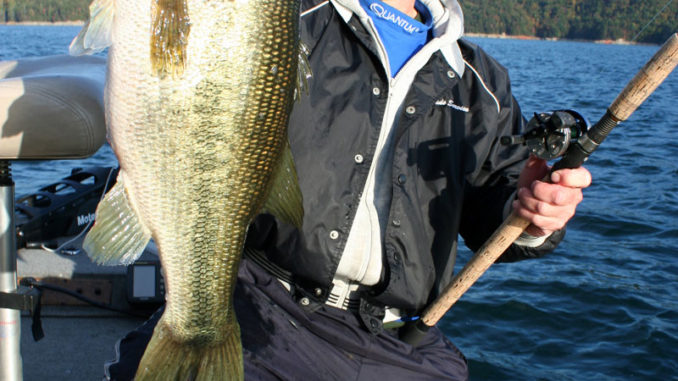
Big swimbaits, floating fly, drop-shot rigs will produce Jocassee’s great bass
The big swimbait sailed through the air and landed like a dead — or at least stunned — trout on the surface of Lake Jocassee. It lay there motionless for a few seconds while Rob McComas shrugged his shoulders to loosen up and focused on the water around the lure. Then, he began working the swimbait back to the boat, reeling slowly, stopping occasionally to give the line a couple of sharp twitches.
Suddenly, McComas tensed and gripped the rod harder as he saw a big shadow closing in on the swimbait. He set the hook as hard as he could, the water around the lure exploded and a huge bass leaped for freedom. McComas held the rod steady, keeping pressure on the big largemouth as it lunged several more times on it’s way to the boat.
“Thank you Lord,” McComas exclaimed as he grasped the bass by the jaw and hoisted it into the boat. A few seconds later, on certified scales he keeps in his boat, McComas weighed the fish at a whopping 9 1/2 pounds. After a few photos, the bass was released, and it swam away to wonder what had happened.
For McComas, it was another Jocassee big fish memory to cherish. When he is not guiding, the Mill Springs, N.C., angler comes to Jocassee to fish for fun, and he’s not just casting for bass, he is going after the giants in the lake. The state-record fish in three of the four black bass species have come from Jocassee: smallmouth, spotted bass and redeye bass.
“It is a most-unique fishery,” said Dan Rankin, regional fisheries biologist for the S.C. Department of Natural Resources. “It has a lot of diversity in the fish populations, and while it is the most-infertile large reservoir in the state, it produces some of the largest largemouth bass in the state.”
Over the past 10 years or so McComas has landed two largemouths over 11 pounds — an 11-pound-2 ounce lunker in 2008 and an 11-pound, 1-ounce bass a year or two before that. He’s also landed spotted bass of 5 pounds, 5 ounces, and 5 pounds, 8 ounces.
“I’ve never caught any giant smallmouth bass, but I have caught them up to 4 pounds on the floating fly, and I’ve never really caught any big redeye bass; maybe 2 1/2 pounds is the largest. They generally are smaller fish,” McComas said.
The redeye population is being hybridized out of existence by the non-native spotted bass, Rankin said. But spots and their redeye-hybrid cousins are fairly plentiful, and when McComas guides a party interested in just catching bass, he brings a bucket of minnows and spinning gear outfitted with drop-shot rigs. Schools of the hybrids roam the feeder rivers and other good habitat areas, such as the Bad Creek outflow system. A live minnow bounced just off the bottom will usually produce spot-redeye hybrids in the 1- to 2-pound range.
McComas fell in love with the mountain lake the first time he fished to it as a teen, and his admiration for the lake’s beauty and fishing potential has grown ever since.
“I was about 16 years old when I went there the first time with a friend of mine and his dad. When I saw the lake, I was mesmerized by it. I just had to learn it,” he said. “I always heard bass fishermen were scared of it. They said it was a tough lake: too deep, too cold for bass. There was just something about it that drew me to it. I think part of it was because people felt it was not a good bass lake and too tough to fish for bass. I did not have much to go on, because there were not a lot of bass fishermen there, so it was not like I could ask people for advice.”
McComas pored over fishing magazines, looking for articles on mountain lakes, taking what he learned and applying it to Jocassee.
“About 90 percent of the articles in most fishing magazines are geared towards more shallow-water lakes, so I did not have a lot to go on,” he said. “There was a lot of trial and error and I spent a lot of fishless days down there, trying different places, fishing in all kinds of different weather. I learned kind of quickly that there were a lot of tactics and tackle that fished different on Jocassee. A lot were just not applicable, because it is so deep and clear.”
McComas said he had to learn to fish outside the normal standards of bass fishing. Where most bass anglers would fish crankbaits, spinnerbaits and worms, he tried different things like jigging spoons and even topwater baits in very cold water during times of the year when that tactic is not productive on most reservoirs.
“It was different lures and different approaches, learning how the fish related. In bass fishing, when you are throwing to a tree or a boat dock or some other structure, you have to realize that the fish relate to structure very differently when they are in 60 to 80 feet of water,” he said. “If you are fishing 6 to 8 feet of water, the fish are laying right there, but on Jocassee, the trees are in 40 to 60 feet of water, so that fish may be 30 feet down under the trees. Because of that depth, you have to fish completely different, have a completely different mind-set and a different approach.”
That approach, he said, means that on Jocassee you have to fish for bass like you are hunting deer: with stealth.
“It’s like you almost have to stalk the big bass on Jocassee,” McComas said. “I think that by the time a fish gets that big, they are smart and more aware of something that is different. They notice the noise you are making, the shadow of the boat, the lures you are fishing. For that reason, long casts are very important.”
Big bass like the 9 1/2-pounder he caught are not sociable, either, he said. They are loners.
“Big fish tend to be singles. You might go into an area and catch schooling fish, but more than likely, you don’t need to be fishing there for big fish,” McComas said. “Big fish will be in big-fish areas, and you have to spend time working those areas. When I am fishing for big fish, I go with the mind-set that I have a good chance of catching nothing, but that doesn’t matter. You have to pay your dues.”
Later the same day that he caught the 9 1/2-pound largemouth, McComas reeled in a 5 1/2-pound largemouth, a 4-pound spotted bass and another nice spotted bass, plus several redeye-spot hybrids. It was the kind of day that bass anglers live for.
“Ninety-nine percent of my guiding is for multi-species on Lake Lure,” McComas said. “ But when I go fishing for fun I go to Lake Jocassee and fish for big fish.”
DESTINATION INFORMATION
HOW TO GET THERE — Lake Jocassee is upstream from Lake Keowee, north of Seneca. Take SC 130 to SC 11 and turn east on SC 11 to Jocasseee Lake Road (SC 25) to the public boat ramp in Devils Fork State Park. From northern Spartanburg County, take Exit 5 off I-26 and head west on SC 11 to Boone Creek Road and Jocassee Lake Road.
TACKLE/TECHNIQUES — Big swimbaits cast towards structure such as sunken trees, stumps, rocky banks and points for big largemouths; floating fly on limber spinning rods and 4-pound-test line for smallmouths and other bass in winter; live minnows fished on drop-shot rigs with light spinning tackle for redeye, spotted and largemouth bass.
GUIDES/FISHING INFO — Rob McComas, Rob’s Guide Service, 828-6745041, www.robsguideservice.org; Jocassee Outdoor Center, 864-944-9016, www.jocasseeoutdoorcenter.com; Keowee Lake Shop, 864-944-1111; Devil’s Fork State Park store, 864-944-2639. See also Guides and Charters in Classifieds.
ACCOMMODATIONS — Seneca Visitors Bureau, 877-685-2537, www.scmountainlakes.com; Devil’s Fork State Park (cabins, camp sites, RV hookups, 866-345-7275, www.southcarolinaparks.com/devilsfork/introduction.aspx.
MAPS — Kingfisher Maps, 800-326-0257, www.kfmaps.com; Duke Energy, www.duke-energy.com/lakes/.

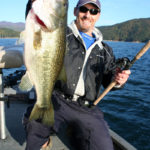
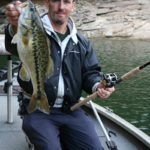
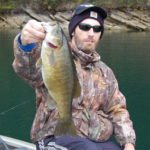
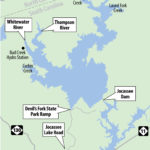
Be the first to comment